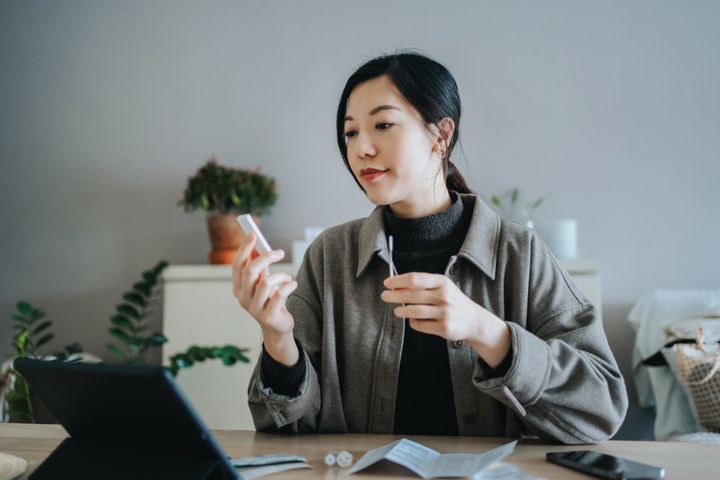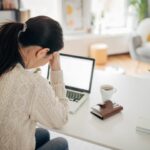By now, you’ve probably read a million articles and instructions on the proper way to swab with an at-home COVID-19 test. You typically need to put the soft end of the swab about half an inch into your nose, swirl it around each nostril for roughly 15 seconds, mix it with some liquid, and let the sample sit in the kit for the exact right amount of time. Then, you want to redo that process every couple of days. (Repeat testing, data shows, significantly improves your chances of getting an accurate test result.)
Now, more recent evidence suggests that you can take your at-home tests to the next level by swabbing more sites than just your nose. Where you swab might matter just as much as when you swab.
A lot of virus needs to be present for rapid tests to produce a positive result, so their performance depends on swabbing where there’s a large amount of virus in your body, scientists say. Sometimes that’s in your nose, and other times it’s not. So the more places you swab, the more opportunities your test kit has to detect the virus.
Here’s why — and how — you might want to perform some additional swabbing the next time you test yourself for COVID-19.
What Experts Have Learned About Swabbing Multiple Sites
Although the Food and Drug Administration only authorizes at-home tests for nasal swabbing at this time, recent research has shown that also testing your throat and mouth (with some discretion) may be the ticket to getting a positive result.
For most people, the COVID-19 virus is detectable in oral samples (aka saliva from the mouth) days before it’s detectable via nasal swabs, according to Natasha Shelby, a study administrator for COVID-19 research at the California Institute of Technology.
In research she’s worked on, some people tested negative with nasal swabs for up to eight days while testing positive with a saliva sample, throat swab or nasal PCR lab test (which is much more sensitive, and therefore accurate, than the kits typically sold at pharmacies).
“In some cases, virus was seen at extremely high and presumably infectious levels in the throat while nasal swabs remained negative,” Shelby told HuffPost — with a small number of infected people never returning a positive result via nasal swabs, likely due to a low viral load in the nose.
“This finding clearly contradicts the popular belief that daily antigen testing is more effective than delayed but high-sensitivity PCR testing,” she said. Testing multiple sites is the way to go, especially early on in an infection since viral loads can vary between different sites, Shelby added.
Here’s How To Properly Swab Yourself
Though there appears to be a benefit to swabbing multiple sites, you don’t want to use the same swab on, say, your throat and nose, according to Rustem Ismagilov, a professor of chemistry and chemical engineering at Caltech and principal investigator for COVID-19 studies at the school. This could actually hurt the performance of tests specifically designed for the nose, he said, so you should use a separate swab for each location.
“When I had to test, I ran two separate tests: one on the throat swab and one on the nasal swab,” Ismagilov said.
Some people on social media report doing the same — receiving a negative result on a nasal swab but a positive result when dabbing their throat.
On the other hand, Dr. Sheldon Campbell, a lab testing expert at Yale Medicine and a professor of pathology at Yale School of Medicine, recommended sticking to the FDA-approved guidance until more data is available. Still, there are other ways to improve your chances of getting an accurate result.
Campbell said you don’t want to start testing yourself immediately after being around someone who has COVID-19 because the odds of testing positive then are slim, even if you’ve been infected. People’s viral loads are typically low at the start of an infection, so he recommended testing yourself every 48 hours — at two days, five days, and seven days after an exposure — or whenever you develop symptoms.
“You want to retest periodically because your chances of getting a positive in an infection improve,” Campbell said.
Another tip is to swab when you first wake up. Shelby’s research team found that taking a COVID-19 test in the morning was more effective than taking it at night.
“If you must use an antigen test, you could increase the effectiveness of that test by taking it first thing in the morning,” she said.
Finally, store-bought tests aren’t meant for older adults, people who are immunocompromised or others at high risk, said Campbell. If you’re potentially vulnerable to serious disease and may require treatment like Paxlovid medication, he recommended that you get a PCR lab test.
Ismagilov said he hopes the FDA will consider more than just nasal swabs for at-home tests in the future. (Canada, the U.K. and Israel have already approved throat-nasal kits.) The agency would have to conduct new studies to re-validate the tests for swabbing other sites, but Ismagilov and other scientists say that’d be worth it in case a new variant emerges that is most detectable in the mouth or throat.
“Knowing which tests work with throat swabs would at least leave us prepared to deal with a variant like that,” Ismagilov said.
Experts are still learning about COVID-19. The information in this story is what was known or available as of publication, but guidance can change as scientists discover more about the virus. Please check the Centers for Disease Control and Prevention for the most updated recommendations.


